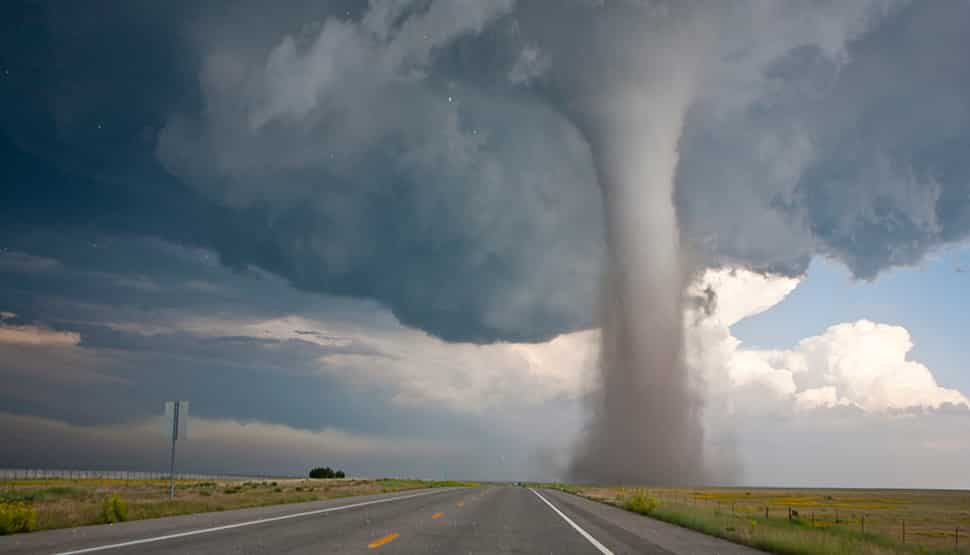Tornado science on the big screen – and at the Research Campus

About 1,200 tornadoes occur every year in the United States. While it’s possible to predict the conditions favorable to tornado formation, it’s difficult with current science and technology to predict their exact location and intensity. They pose a significant challenge in tornado-prone areas of the United States.
They’re also very much in the cultural conversation right now: In mid-July, the movie “Twisters” – the sequel to the 1996 blockbuster “Twister” – hit theaters. The new film presents an opportunity to talk about tornado research and resilience.
Recently a documentary crew visited FM’s Research Campus in West Glocester, Rhode Island, USA to do just that. Their piece is called “American Tornadoes: Minutes to Survive, Years to Rebuild.”
In the documentary, FM Chief Science Officer Dr. Louis Gritzo demonstrated the debris cannon at our Natural Hazards Laboratory for professor and co-host Juliette Kayyem. The cannon first fires a two-by-four at a half-inch piece of plywood. It sails right through the wood. Then, the two-by-four is fired at an inch thick piece of plywood. It bounces right off.
“That’s the ideal outcome,” Gritzo says when the two-by-four clattered to the ground. “If it can protect against something flying in a storm like this, we can keep the envelope of that structure intact. That’s really the name of the game for tornadoes.”
Far from YouTube or the silver screen, FM’s research into natural hazards like tornadoes remains ongoing. Here are a few more insights our clients should know.
Tornado climate trendsYou’ll sometimes hear that tornadoes have become more common in the United States over the past few decades. But that leaves out some key facts: We have a lot more radar coverage, population density and improved reporting methods than we did decades ago. That means we’re identifying more tornadoes, but it doesn’t necessarily mean they’re more common. And while the climate is changing, the way tornadoes may be changing with the climate is not yet well understood.
“It’s a very active research area,” said Shangyao Nong, senior lead research scientist at FM. “But the reliable record on U.S. tornadoes only goes back to roughly 1950. There is not sufficient observational data to draw any conclusions.”
There are some indications that “Tornado Alley” – the place in the United States where tornadoes occur most frequently – might be trending eastward, Nong said. If the trend eastward continues, it could put more populated areas, and therefore more property, at risk. Whether that trend shows up in more property damage claims remains to be seen. There are also some indications that tornadoes are happening more in concentrated clusters – fewer days with tornadoes, but more tornadoes happening on those days.
In 2018, FM released a white paper called “Defy The Twister,” which explored tornadoes in the age of climate change. Leading tornado research scientists and our own experts noted that there are some contradictory forces at play with respect to tornadoes and climate change: Increases in temperature and moisture in a future climate are likely to increase Convective Available Potential Energy, which creates the conditions for strong thunderstorm updrafts. But vertical windshear is projected to decrease, which is not conducive to thunderstorms for violent tornadoes. The combined effect isn’t well understood.
What we’re doing to understand tornadoesIn recent years FM partnered with the Wind Engineering, Energy and Environment Research Institute at Western University to deepen our understanding of tornadoes. The research used a specially designed wind tunnel to simulate a tornado-like vortex in order to better estimate wind load, or the pressure force that a real-life tornado exerts on a building. FM is also involved in research with Texas Tech University to understand wind loads on commercial buildings caused by tornadoes. Refining our knowledge of wind load will give us more confidence when we give our clients recommendations on how to minimize potential tornado damage to a building.
Data from the research could help reduce uncertainty when a client is trying to design a building that could potentially survive an EF1, EF2 or even the low end of an EF3 tornado, Nong said. The data from this research is still being analyzed.
At FM’s Research Campus in West Glocester, in addition to the debris cannon we can also test products like roof and wall assemblies to see how they hold up against strong winds that tornadoes or hurricanes can bring. They provide visceral illustrations of the benefits of proactive risk prevention strategies.
More practical steps for tornado resilienceMany of the things property owners can do to prepare for tornadoes are the same things they can do to prepare for hurricanes.
Property owners can:
- Harden the building envelope, including walls, doors, windows, skylights, roof-mounted equipment and roofs.
- Reduce the sources of wind-borne debris.
- Create interior safe zones for people.
- Establish robust power sources.
“Defy The Twister” has a full list of steps property owners can take.
Of the 1,200 or so tornadoes that occur in the United States, almost 90% are EF0 or EF1 tornadoes, with wind gusts between 65 miles per hour on the low end of an EF0 and 110 miles per hour on the high end of an EF1. The steps FM advises for hurricanes are applicable to the vast majority of tornadoes.
But for the very strong and rare tornadoes – an EF3 and higher – there is only so much a property owner can do to prevent catastrophic destruction.
That’s why it’s key to have an insurance company with almost 200 years of engineering experience working as a partner in protection.
